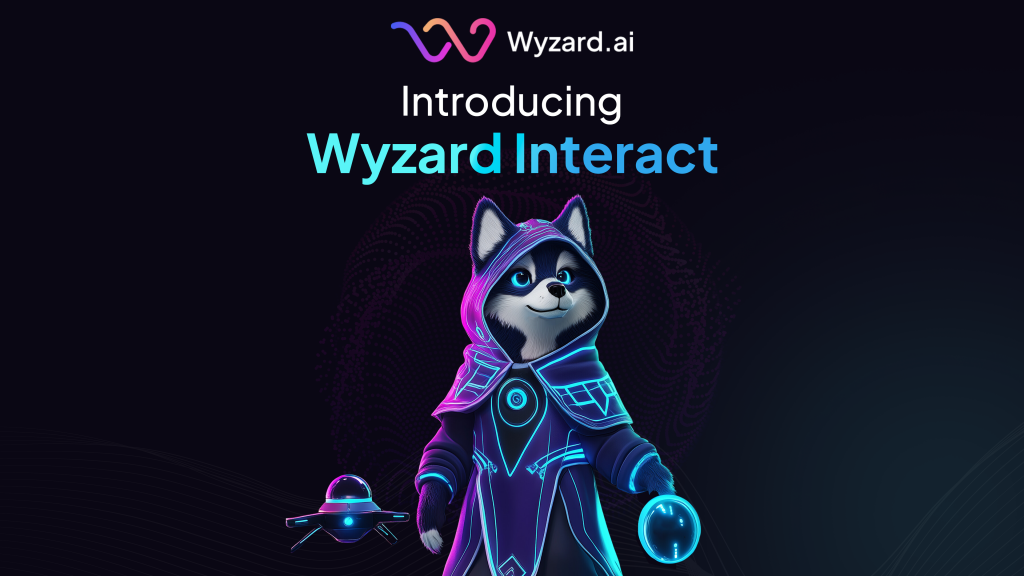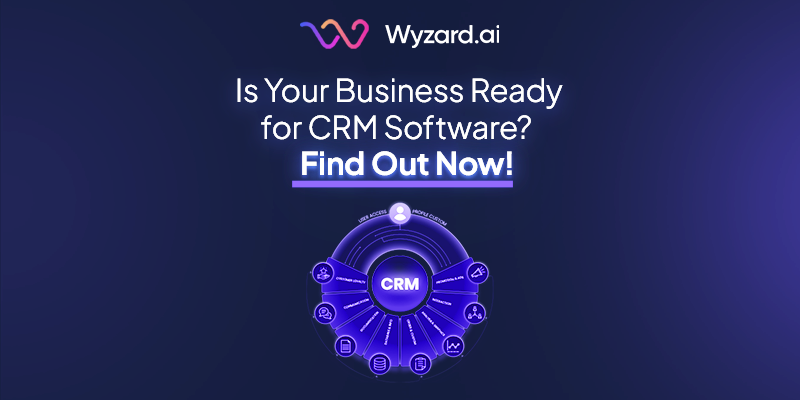Hi, I am Wyzard, your visionary guide in a world where the buying experience is transforming. The way we ...
SaaS Shadow IT Silently Drains Your Budget: How SaaS Management Platforms Can Help
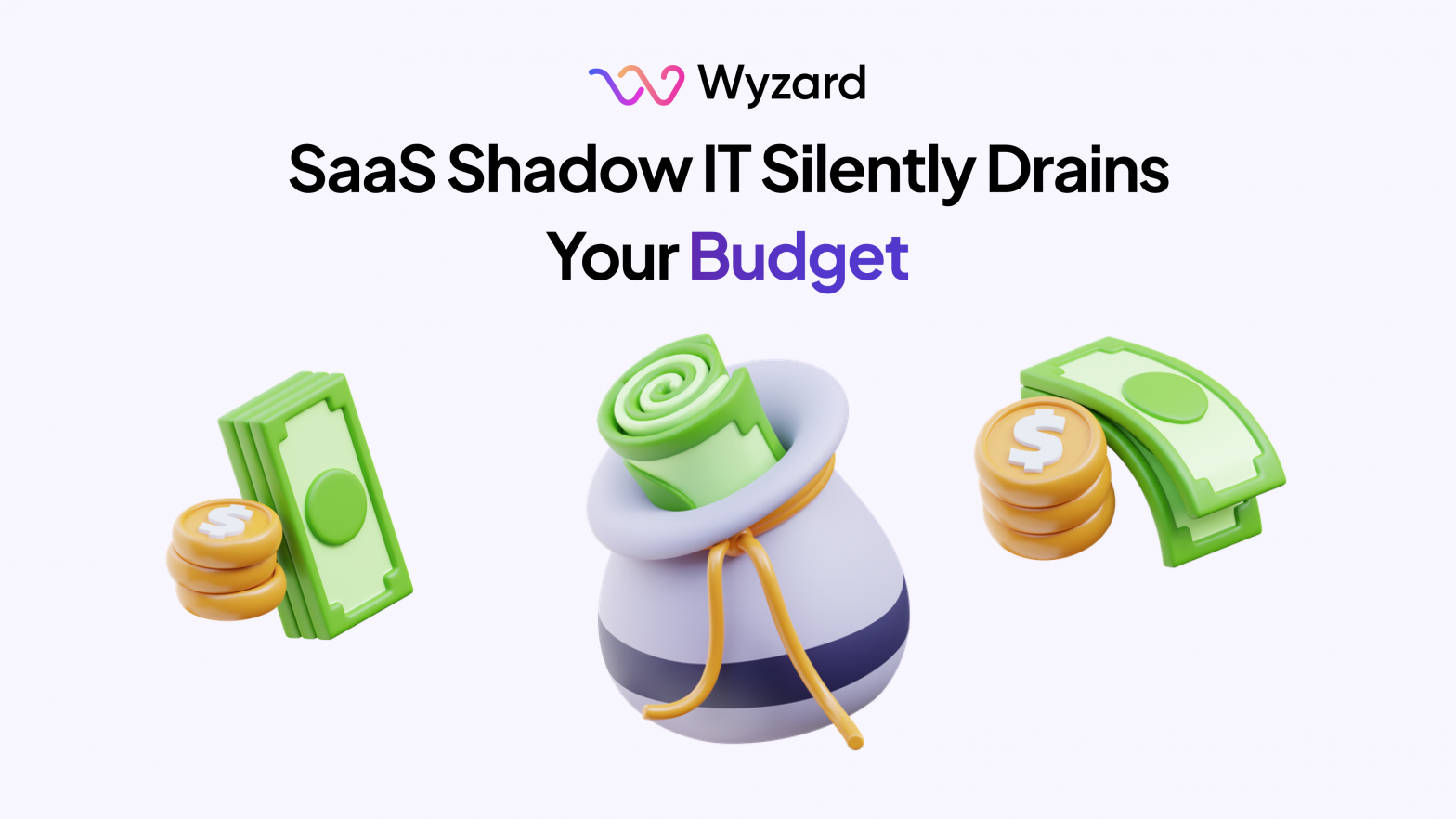

Subscribe Now
Every day the number of SaaS applications in shadow is increasing — where your IT and procurement teams are not looking.
A recent survey found that 80% of employees use unapproved software applications for work purposes. This unauthorised use of cloud services, often without the IT department’s knowledge, is known as SaaS shadow IT.
Shadow IT has a significant financial impact—it’s estimated to account for up to 50% of an organisation’s total SaaS spending.
If left unchecked, shadow IT can lead to serious problems, such as security breaches, compliance violations, and operational disruptions.
In this blog, we’ll discuss the risks associated with SaaS shadow IT and how SaaS management platforms can help you regain control and optimise your software investments.
What is SaaS Shadow IT?
SaaS shadow IT refers to the practice of employees using cloud-based software applications without the knowledge or approval of the IT/procurement department. This happens when employees independently purchase and start using SaaS tools for their work, bypassing the official procurement and vetting processes.
There are several reasons why shadow IT occurs. Sometimes, employees find the approved software tools inadequate or difficult to use, prompting them to seek alternative solutions on their own.
In other cases, lengthy approval processes or tight IT budgets may drive employees to take matters into their own hands to buy the SaaS tools they need quickly.
For example, let’s say a marketing team needs a new project management tool, but the request gets stuck in bureaucracy. Instead of waiting, they may subscribe to a popular SaaS project management app using a company credit card without informing IT. This unmanaged purchase and usage constitute shadow IT, which can lead to various risks for the organization.
Why is SaaS Shadow IT on the rise?
One of the main reasons behind the rise of shadow IT is the explosive growth of the SaaS market itself.
Numbers from the research firm Gartner show that in 2021, companies spent over $145 billion on SaaS apps. And get this—by the end of 2023, the spending reached more than $195 billion! That’s an insane amount of growth in just a couple of years.
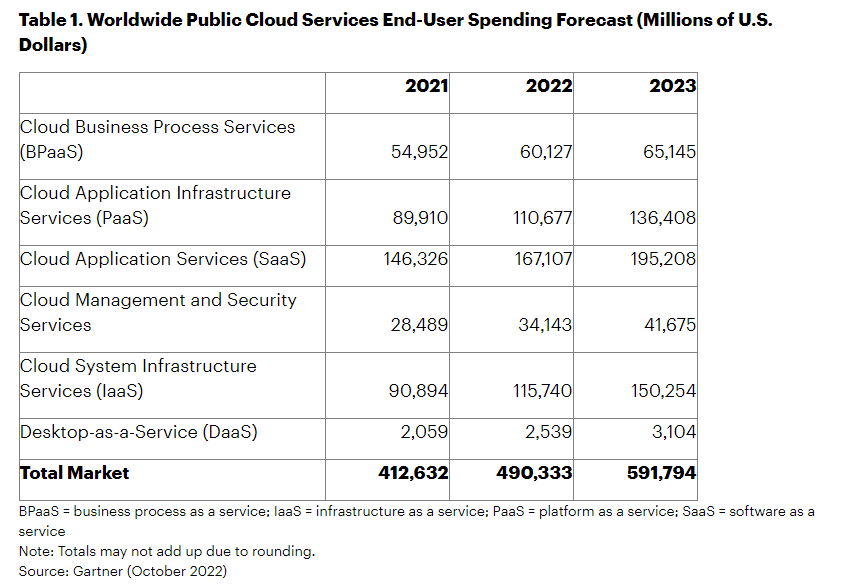
However, many of those SaaS purchases are no longer made and controlled by the IT department. Instead, individual business units and teams within companies use their own budgets to buy software tools.
According to IDC’s projections, almost 70% of all SaaS app purchases nowadays come straight out of those business budgets, not the central IT budget. And when these teams buy apps without looping in IT, boom—you’ve got a shadow IT situation on your hands.
In simple terms, the SaaS market is booming. The purchasing power has shifted to individual business units, which sets up the situation for shadow IT to really take off within organizations.
What are the risks that come with SaaS Shadow IT?
Shadow IT poses severe risks to organizations, and it’s crucial to understand and address these risks proactively.
Let’s explore the key areas of concern in detail:
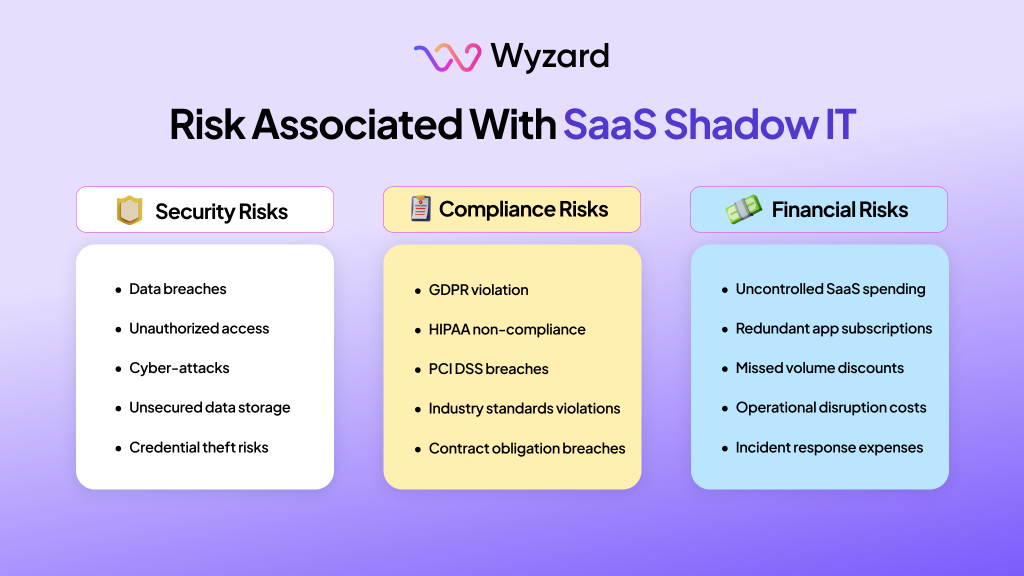
1. Security risks
Data breaches and unauthorized access are significant threats when employees use unapproved software applications.
These unsanctioned tools often lack proper security protocols and may not receive regular security updates or patches, exposing sensitive data to potential cyber-attacks.
Without central oversight, organizations lose control over data storage locations and access management, making it challenging to ensure that sensitive information is stored securely and accessed only by authorized individuals.
Additionally, the practice of password reuse across multiple accounts is common among employees, increasing the risk of credential theft. If a hacker gains access to one account, they may potentially compromise other critical systems and data.
The risk of data breaches and cyber-attacks is amplified when organizations cannot monitor and secure the entire technology stack due to shadow IT. And you must know the cost of a data breach—it’s $4.45 million.
2. Compliance and regulation risks
Some industries like healthcare and finance are subject to strict data privacy regulations like GDPR, HIPAA, and PCI DSS. These regulations outline specific requirements for data handling, storage, and security.
When employees use unauthorized software applications that have not undergone proper vetting, there is a heightened risk of violating these regulations.
Failure to comply can result in severe legal penalties, substantial fines, and significant damage to an organization’s reputation.
Moreover, shadow IT can lead to non-compliance with industry-specific standards and client contractual obligations, further compounding the risks.
3. Financial risks
Shadow IT can wreak havoc on an organization’s finances in multiple ways. Unplanned and uncontrolled SaaS spending across departments can quickly spiral out of control, leading to budget misalignment and inefficient resource allocation.
Employees or teams may unknowingly purchase redundant application subscriptions or licenses, resulting in a waste of funds.
Furthermore, when SaaS purchases occur outside IT’s purview, it becomes challenging to use your consolidated buying power and negotiate favourable pricing agreements.
In the event of a data breach or application downtime caused by shadow IT, the disruption to business operations can result in substantial financial losses. Productivity can halt, and you may face additional costs associated with incident response, recovery efforts, and potential legal fees, which is a lot.
It’s important to note that while shadow IT often stems from employees’ genuine efforts to find solutions to their work challenges, the potential consequences are far-reaching and can undermine your security, compliance, and financial stability.
Addressing shadow IT through proactive measures is essential to mitigate these risks and ensure the organization’s long-term success. And that’s what we discuss in the next section.
How SaaS Management Platform Can Help You Eliminate Shadow IT?
While Cloud Access Security Brokers (CASB) and traditional IT Asset Management (ITAM) tools can provide some visibility into shadow IT, they often fall short when it comes to fully eliminating this problem, especially when it comes to SaaS applications.
For example, let’s say your organization uses a collaboration tool like Slack, which has 15 channels and over 100 teams. A CASB solution might be able to detect that Slack is being used. Still, it won’t give you specific details like who operates each channel or any information related to licensing and user access levels.
Similarly, ITAM tools are primarily designed to manage hardware assets like servers, computers, and printers, as well as on-premise software installations. However, the bulk of modern shadow IT is cloud-based SaaS applications, which fall outside the scope of traditional ITAM solutions.
This is where a dedicated SaaS Management Platform can help you in your battle against shadow IT.
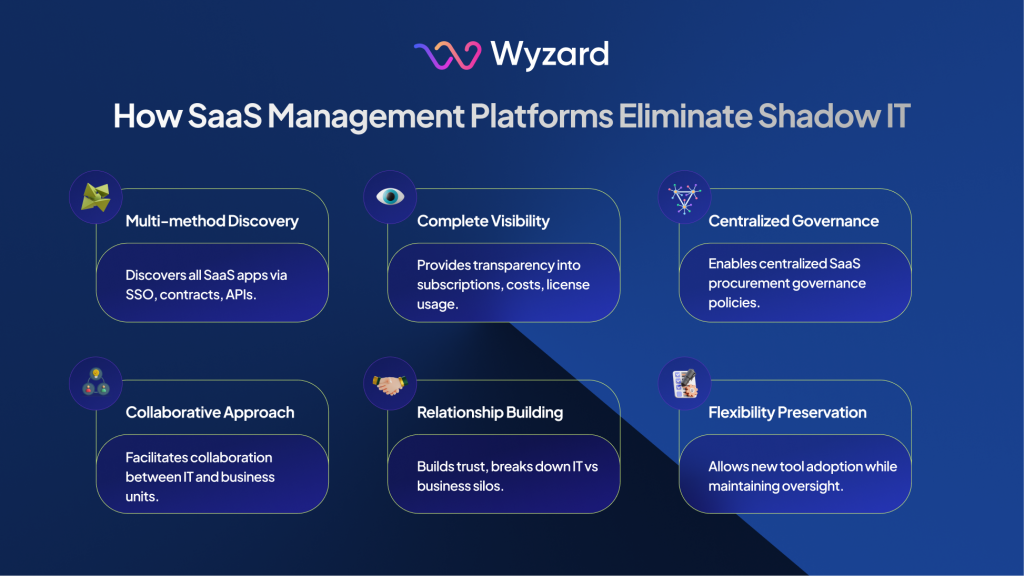
1. These platforms collect data in multiple ways
Unlike CASB and ITAM tools, which have limited visibility into SaaS apps, Wyzard, a SaaS Management Platform, uses multiple discovery methods to identify every single SaaS application used within your organization. This includes:
- Single Sign-On (SSO) Integration: By integrating with your organization’s SSO provider (such as Okta, Azure AD, or Google Workspace), Wyzard can trace app users, their departments, roles, and the types of applications being accessed.
- Contract and Procurement Data: Wyzard can analyze all your contracts with AI, allowing it to discover SaaS applications purchased through official channels.
- Direct API Connections: Wyzard establishes direct API integrations with leading SaaS vendors, giving it access to granular usage data, licensing information, and audit logs for those specific applications.
This multi-pronged approach ensures that no SaaS application falls through the cracks, solving a key limitation of CASB and ITAM solutions.
2. Gain visibility into SaaS purchases
With a SaaS Management Platform like Wyzard, you can finally gain complete transparency into every SaaS application being purchased and used across your entire organization. This visibility extends to details like subscription costs, license types, user roles, and more.
3. Know who uses which software
Perhaps more importantly, these platforms help you understand which teams and individuals are using specific SaaS tools. This insight enables you to build relationships with key stakeholders and decision-makers across different business units.
When you know the SaaS decision-makers within each team, you can proactively reach out to them, understand their needs, and provide guidance on approved solutions or negotiated enterprise pricing. This collaborative approach builds trust and breaks down silos between IT and other departments.
4. Centralize SaaS governance with stakeholder alignment
With this SaaS visibility and cross-functional stakeholder relationships, you can finally implement a centralized governance policy to regulate SaaS procurement across your organization.
Instead of teams going rogue and subscribing to shadow IT apps, they’ll be incentivized to loop you in from the start. You can guide them towards approved, secure and cost-effective solutions while still giving them the flexibility to adopt the new tools they need.
This centralized approach helps curb wasteful SaaS spend, mitigates security and compliance risks associated with shadow IT, and builds a more collaborative, cohesive relationship between IT and the rest of the business.
It’s time to cut SaaS Shadow IT down to size with Wyzard
Let’s be real—SaaS shadow IT is never going to disappear entirely. As long as employees have the ability to procure software independently, some level of unsanctioned app usage will persist.
But that doesn’t mean you have to let it spiral out of control.
With Wyzard, a SaaS management platform, you can reduce shadow IT to a manageable level where it no longer poses major risks or drains resources from your organization.
Through features like SSO integration, contract monitoring, and direct vendor API connections, Wyzard identifies every single SaaS app being used, leaving no shadowy corners for rogue subscriptions to hide.
It gives you the visibility to implement centralized governance, collaborate with stakeholders across teams, and steer them towards secure, cost-effective solutions.
So why stumble around in the dark, tripping over shadow IT? Book a demo with Wyzard today!
Other blogs
The latest industry news, interviews, technologies, and resources.
March 17, 2025
How LLM-Based AI Agents are Simplifying the Software Buying Process for Businesses
Let’s talk about something that’s becoming a game-changer in our daily lives: AI agents. Think of them as your ...

March 11, 2025
Is Your Business Ready for CRM Software? Find Out Now!
Running a small business can feel like juggling a million things at once. You are busy with customers, ensuring ...

Subscribe
Today!
Error: Contact form not found.
Subscribe to learn about new product features, the latest in technology, solutions, and updates.
 Meet Us at
Meet Us at 
